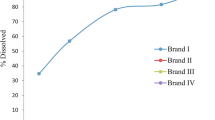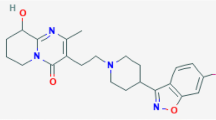Abstract
We have recently demonstrated that coprecipitation of cimetidine (C) and piroxicam (P) at a mole ratio of 1:1 results in the transformation of the crystalline forms of both drugs to an amorphous state. In this study, coprecipitates and physical mixtures of cimetidine and piroxicam were further investigated at C/P mole ratios of 1:10, 1:5, 1:4, 1:2, 10:1, 20:1, 30:1, 40:1, and 52.5:1, the latter being the composition of a clinically used dosage. The physicochemical properties of these samples were examined using X-ray diffraction and Fourier transform infrared spectroscopy. Additionally, dissolution of piroxicam in the samples at C/P mole ratios of 10:1, 20:1, 30:1, 40:1, and 52.5:1 was investigated at pH 1.2 and pH 4. In coprecipitates with C/P mole ratios of 10:1, 20:1, 30:1, and 40:1, crystalline forms of both drugs were transformed to amorphous states. A mixture of an amorphous state and cimetidine crystalline form A was observed for the coprecipitate with a C/P mole ratio of 52.5:1. For the coprecipitates with C/P mole ratios of 1:2, 1:4, 1:5, and 1:10, cimetidine form A was transformed to form C, whereas piroxicam form II was modified to form I. It is interesting that small molecules, instead of polymers or solvents, can cause such crystal structure transformations. The dissolution of piroxicam at pH 4 is lower than that at pH 1.2. Additionally, the coprecipitates and physical mixtures with C/P mole ratios of 10:1, 20:1, 30:1, 40:1, and 52.5:1 demonstrate substantially higher dissolution of piroxicam compared to that of drug alone.









Similar content being viewed by others
References
Morre DJ, Morre DM. tNOX, an alternative target to COX-2 to explain the anticancer activities of non-steroidal anti-inflammatory drugs (NSAIDS). Mol Cell Biochem. 2006;283:159–67.
Knottenbelt C, Chambers G, Gault E, Argyle DJ. The in vitro effects of piroxicam and meloxicam on canine cell lines. J Small Anim Pract. 2006;47:14–20.
Semble EL, Wu WC. Antiinflammatory drugs and gastric mucosal damage. Semin Arthritis Rheum. 1987;16:271–86.
Finkelstein W, Isselbacher KJ. Drug therapy: cimetidine. N Engl J Med. 1978;299:992–6.
Takahashi HK, Watanabe T, Yokoyama A, Iwagaki H, Yoshino T, Tanaka N, et al. Cimetidine induces interleukin-18 production through H2-agonist activity in monocytes. Mol Pharmacol. 2006;70:450–3.
Lefranc F, Yeaton P, Brotchi J, Kiss R. Cimetidine, an unexpected anti-tumor agent, and its potential for the treatment of glioblastoma (review). Int J Oncol. 2006;28:1021–30.
Maciel HP, Cardoso LG, Ferreira LR, Perazzo FF, Carvalho JC. Anti-inflammatory and ulcerogenic effects of indomethacin and tenoxicam in combination with cimetidine. Inflammopharmacology. 2004;12:203–10.
Milligan PA, McGill PE, Howden CW, Kelman AW, Whiting B. The consequences of H2 receptor antagonist-piroxicam coadministration in patients with joint disorders. Eur J Clin Pharmacol. 1993;45:507–12.
Said SA, Foda AM. Influence of cimetidine on the pharmacokinetics of piroxicam in rat and man. Arzneimittelforschung. 1989;39:790–2.
Wu CY, Benet LZ. Predicting drug disposition via application of BCS: transport/absorption/elimination interplay and development of a biopharmaceutics drug disposition classification system. Pharm Res. 2005;22:11–23.
Wilson WI, Peng Y, Augsburger LL. Generalization of a prototype intelligent hybrid system for hard gelatin capsule formulation development. AAPS PharmSciTech. 2005;6:E449–57.
Jantratid E, Prakongpan S, Amidon GL, Dressman JB. Feasibility of biowaiver extension to biopharmaceutics classification system class III drug products: cimetidine. Clin Pharmacokinet. 2006;45:385–99.
Vrecer F, Vrbinc M, Meden A. Characterization of piroxicam crystal modifications. Int J Pharm. 2003;256:3–15.
Sheth AR, Bates S, Muller FX, Grant DJW. Polymorphism in piroxicam. Cryst Growth Des. 2004;4:1091–8.
Baranska M, Proniewicz LM. FT-IR and FT-Raman spectra of cimetidine and its metallocomplexes. J Mol Struct. 1999;511–512:153–62.
US Pharmacopeia. US Pharmacopeia 27 and National Formulary 22 (USP27 and NF22). Rockville: US Pharmacopeia; 2004.
Kim KH, Frank MJ, Henderson NL. Application of differential scanning calorimetry to the study of solid drug dispersions. J Pharm Sci. 1985;74:283–9.
Hegedus B, Gorog S. The polymorphism of cimetidine. J Pharm Biomed Anal. 1985;3:303–13.
Otsuka M, Kato F, Matsuda Y. Physicochemical stability of cimetidine amorphous forms estimated by isothermal microcalorimetry. AAPS PharmSciTech. 2002;3(4):30.
Middleton DA, Duff CSL, Berst F, Reid DG. A cross-polarization magic-angle spinning 13C NMR characterization of the stable solid-state forms of cimetidine. J Pharm Sci. 1997;86:1400–2.
Sheth AR, Bates S, Muller FX, Grant DJW. Local structure in amorphous phases of piroxicam from powder x-ray diffractometry. Cryst Growth Des. 2005;5:571–8.
Tantishaiyakul V, Permkam P, Suknuntha K. Use of DRIFTS and PLS for the determination of polymorphs of piroxicam alone and in combination with pharmaceutical excipients: a technical note. AAPS PharmSciTech. 2008;9:95–9.
Bauer-Brandl A. Polymorphic transitions of cimetidine during manufacture of solid dosage forms. Int J Pharm. 1996;140:195–206.
Middleton DA, Duff CSL, Peng X, Reid DG, Saunders D. Molecular conformations of the polymorphic forms of cimetidine from 13C solid-state NMR distance and angle measurements. J Am Chem Soc. 2000;122:1161–70.
H. Birkedal, A. Bauer-Brandl, and P. Pattison. The surprising polymorph C of cimetidine: synchrotron radiation to the rescue, XIXth European Crystallographic Meeting, Abstracts. Acta Cryst. A56 (Supplement), s337, Nancy, France, 2000.
Taddei P, Torreggiani A, Simoni R. Influence of environment on piroxicam polymorphism: vibrational spectroscopic study. Biopolymers. 2000;62:68–78.
Thomson AB, Kirdeikis P, Zuk L. Comparison of 200 mg cimetidine with multiple doses of antacid on extent and duration of rise in gastric pH in volunteers. Digest Dis Sci. 1999;44:2051–5.
Karlstadt RG, Hedrich DA, Asbel-Sethi NR, Palmer RH. Acid-suppression profile of two continuously infused intravenous doses of cimetidine. Clin Ther. 1993;15:97–106.
Avdeef A. Physicochemical profiling (solubility, permeability and charge state). Curr Top Med Chem. 2001;1:277–351.
Gerk PM, Oo CY, Paxton EW, Moscow JA, McNamara PJ. Interactions between cimetidine, nitrofurantoin, and probenecid active transport into rat milk. J Pharmacol Exp Ther. 2001;296:175–80.
Avdeef A, Berger CM. pH-metric solubility: 3. dissolution titration template method for solubility determination. Eur J Pharm Sci. 2001;14:281–291.
Katrukha SP, Davydov SM, Selina EV, Kukes VG. Determination of cimetidine in blood plasma by high performance liquid chromatography. Pharm Chem J. 1988;22:85–7.
Grant DJW. Theory and origin of polymorphism. In: Brittain HG, editor. Polymorphism in Pharmaceutical Solids, vol. 95. New York: Marcel Dekker; 1999. p. 1–33.
Maton PN. Review article: prevention of stress-related mucosal bleeding with proton-pump inhibitors. Aliment Pharm Therap. 2006;22:45–52.
Acknowledgements
This work was supported by Prince of Songkla University.
Author information
Authors and Affiliations
Corresponding author
Rights and permissions
About this article
Cite this article
Tantishaiyakul, V., Songkro, S., Suknuntha, K. et al. Crystal Structure Transformations and Dissolution Studies of Cimetidine–Piroxicam Coprecipitates and Physical Mixtures. AAPS PharmSciTech 10, 789–795 (2009). https://doi.org/10.1208/s12249-009-9263-9
Received:
Accepted:
Published:
Issue Date:
DOI: https://doi.org/10.1208/s12249-009-9263-9




